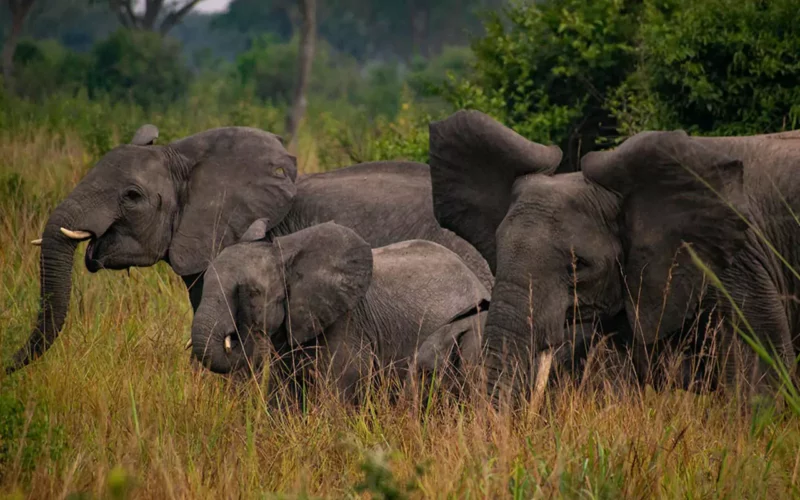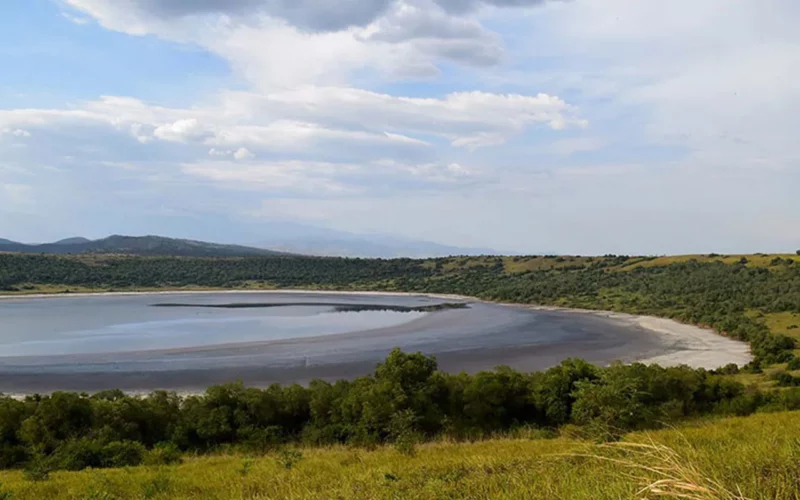The biosphere park of Queen Elizabeth National (QENP) is the most diverse protected area in Uganda. Lying along the Albertine rift valley floor in the backdrop of the legendary “Mountains of the Moon”, QENP was gazetted in 1952 as Kazinga National Park to protect the varied landscape and prolific wildlife between Lake Edward and the Rwenzori Mountains but was renamed in 1954 to commemorate the visit of the British Royal Monarch, Her Majesty Queen Elizabeth 2.
The expansive biodiversity-rich area of 1978km2 is associated with diverse habitats that include open savanna grasslands, acacia woodlands, tropical forests, wetlands, open water and the famous forested Kyambura Gorge, supporting a total of 95 mammal species and 660 bird species; the highest number of bird species recorded for any protected area of such a size on the continent.
Quick Facts:
- First gazetted 1920 as Kazinga Channel but renamed Queen Elizabeth in 1954
- Altitude: 912m–1360m.
- Size: 1978km2
- Birds checklist: 660 species, a true bird-hot spot.
- Mammal checklist: 95 species
Activities to Do while in Queen Elizabeth National Park

-
Take Prolific Wildlife Safari Game Drives
Queen Elizabeth National Park offers an incredible wildlife safari experience on game drive and boat safaris across the park’s diverse habitats of savanna plains, woodlands, forests and open water. This diversity of wildlife includes; Uganda Kob (Kobus kob), Deffassa Water Buck, Cape Buffalo, Savanna Elephant, Forest Hog, Bushbuck and more.
Predators include; Lions, Spotted Hyena, Spotted Genet, Side-striped Jackal and the elusive Leopard. Warthogs and Banded mongoose are the other not-minded species!! Giant forest Hog is encountered on wooded tracks.
-
Climbing Lions Prides of Ishasha
One popular highlight while on safari in Queen Elizabeth NP is to encounter the famous tree climbing lions on a game drive through the grassland plains in Ishasha in the southern sector of the park. These unique lion prides are notoriously known to lounge up in several fig and albizzia tree branches during the heat of the day. This rare and unique behavior adapted by the lion prides of Ishasha is thought to either escape the nasty stinging insects or just to have a good look across their vast game-rich territory is subject to discussion!!
Other wildlife here include; Topi (a race unique to this area), Uganda Kob, Cape Buffalo, Common Warthog, Deffassa Waterbuck among others. Spotted Hyenas and Leopards are often seen. Woodlands are tamed by Elephants, while the Ishasha River is teamed by schools of Hippos and the Nile Crocodile.
-
Take a Boat Cruise Safari on the Kazinga Channel
Kazinga channel ofters one of the most exciting boat safaris on any Uganda safari. Stretching up to 40km long and connecting lakes Edward (912m) and George (913m), Kazinga Channel is a wildlife hotspot noted for the densest concentration of hippos among a plethora of wildlife. A boat cruise safari launches from Mweya Peninsula to explore the channel banks towards the mouth of L. Edward bringing you up close to the Elephants, Hippos, Kob and herds of Buffalos as they quench their thirsty.
The channel is a birding hotspot and a recognized Important Bird Area (IBA) hosting tens of thousands of migrating birds on their winter visit but local resident waders and other water associated species occur.
-
Bird Watching in Queen Elizabeth NP
With a checklist of over 660 bird species from its varied habitats, Queen Elizabeth National Park one of top birding hotspots in the region. The checklist is collected from the parks varied bird-rich habitats that include vast tropical forests, open water, wetlands, savanna grasslands and woodlands, hosting various biome restricted species.
While birding across these plethora of habitats highlights include; Bateleur, Tawny Eagle, Martial Eagle, Black-snake Eagle, Giant Kingfisher, African Fish Eagle, White-headed, Lappet-faced Vultures among the raptors. On grasslands Wattled Lapwing, Flappert, Red-capped Larks, Termick’s Courser, Rufous-naped Lark occur.
Birding the vast Imaramagambo forest specialists include; Blue-breasted Kingfisher, Yellowbill, Toro Olive Greenbul, Forest Robin, Narina Trogon, Western Black-headed Oriole, Red-tailed Bristle bill, Blue-shouldered Robin Chat, Olive-bellied Sunbird, Brown Illadopsis, Afep Pigeon, African Pied Hornbill among others.
Wetland specialists along the Kazinga channel include; Papyrus Gonolek, White-winged Swamp Warbler, Malachite Kingfisher while further north the Ramsar recognized marshes of L. George are famous and breeding ground for the prehistoric Shoebill. Several crater lakes like Munyanyange are seasonal hosts of migrants like Lesser Flamingos, Whiskered Terns, Little Stints, and others.
-
Chimpanzee Tracking at Kyambura Gorge and Kalinzu Forest
The underground forest of Kyambura Gorge offers one of unrivaled chimpanzee tracking experience in the country owing to the uniqueness of this habitat. This riverine rainforest within the Kyambura Gorge lies about 100m below the golden savannas to stretch 16km long and over 1km wide. The gorge protects a 45-strong community of chimpanzee that call this underground forest home and available for daily treks. Chimpanzee trekking experience begins early in the morning led by ranger guides to follow trails that crosses various feeding ranges of this local chimp group. On locating them, you are accorded one-hour with the chimps. Other primates seen on trek include Black and White Colobus, Red-tailed Monkey, Vervet and Olive Baboon. Bigger angulates include Forest duikers, Giant Forest Hog but Savanna Elephants, Buffalos and Hippos visit. The trek experience duration varies daily but 4-6hrs is normal.
Another Chimpanzee trekking experience is offered at the mid-altitude Kalinzu Forest set on the eastern flanks of Queen Elizabeth NP. And although it is often dismissed in favor of the well established Kibale Forest for chimpanzee treks, Kalinzu offers an equally and even better experience. This is because Kalinzu Forest attracts low numbers of visitors and lower fees makes the experience personal and exclusive. The forest spreads along the ridges and valleys of the rift valley escarpment wall, protecting hosting an exciting, habituated community of chimps that offers incredible up-close experience.
Other primates include the Blue and L’hoest Monkeys, Black and White (Guereza) and Red-tailed Monkeys, Grey-cheecked Mangabey and a rich bird, butterfly and tree-specie list. Here at Kalinzu chimpanzee experience stretches between 4-6hrs.

-
Explore the Dazzling and Explosion Crater Lakes
The volcanic activity that shaped the rift valley where Queen Elizabeth NP lies left behind a stunning landscape ranging from the distant Rwenzori mountain ranges, explosion craters, escarpment and plains. The park’s landscape is pocked with a number of extinct craters with the most scenic lying along the 27km scenic crater drive track. These are filled with various vegetation types from forest, woodlands and savanna grasslands to saline muddy waters that attracts buffalos. The drive offers one panoramic views of the Rift valley floor including the Rwenzori mountain ranges, Kazinga Channel and Lake George.
Of these craters, the most scenic are Katwe and Bunyampaka salt lakes where for centuries salt mining activity is done using age-old traditional methods. Other nearby craters are Important birding Area attracting migrating birds among them thousands of Lesser Flamingos (and at less extent Greater Flamingos) to feed on their algae-filled shallow waters. Several other lakes are scattered along the Bunyaruguru escarpment and can be explored on foot through villages exposing one to diverse agricultural practices on the steep slopes and rims of these craters.
-
Take a Nature Walk in the vast Imaramagambo Forest
Usually overlooked by most travelers, is this vast medium altitude 750km2 Imaramagambo forest that flank most of the eastern wall ridges of the rift valley. This medium altitude forest have excellent trails that explores forest interior where up to 10 primates including the chimpanzee, L’hoest Monkey, Blue and Red-tailed Monkey occur. Birdlife is excellent notable the afro-tropical specialists and generalists. Trails continue on to scenic crater lakes and bat caves where millions roost. Guided nature walks here from short-to-full walks.
